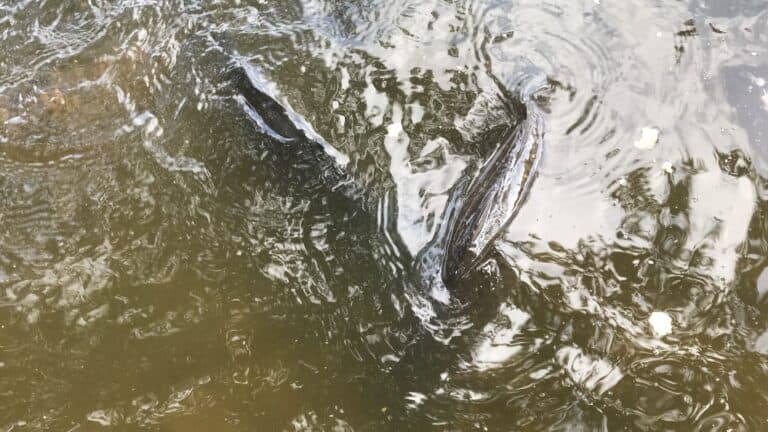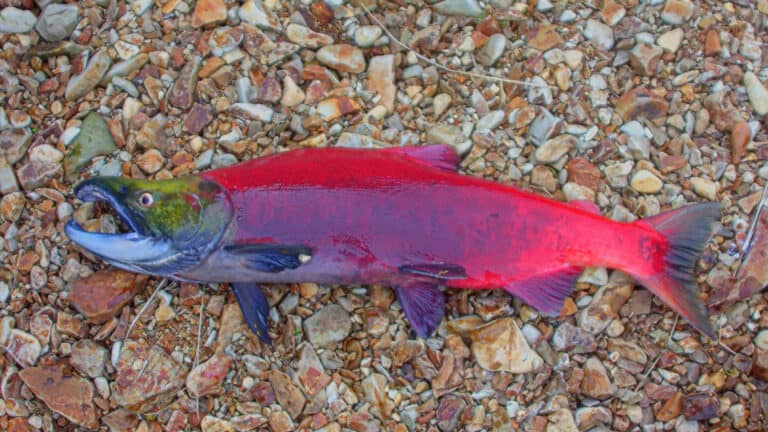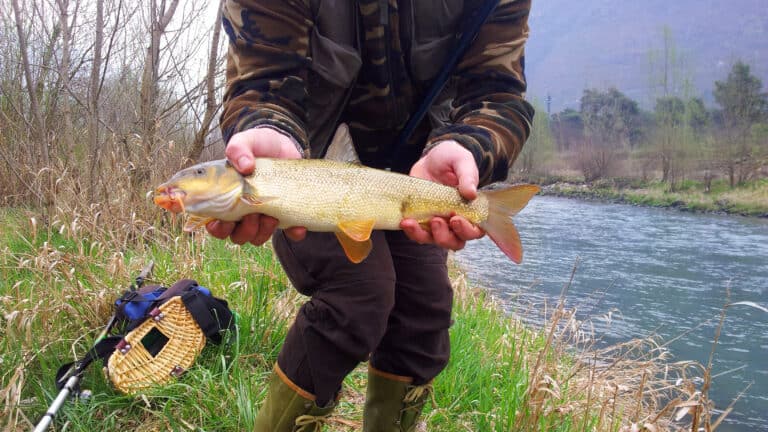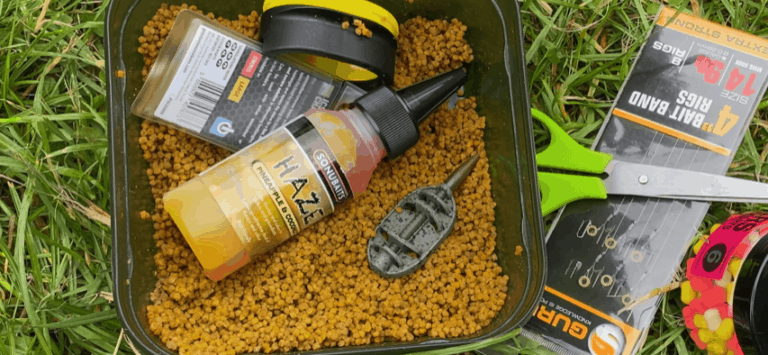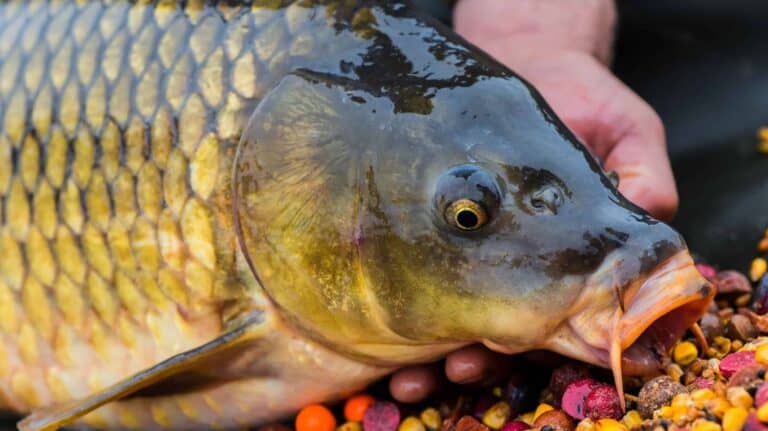Float fishing vs Feeder fishing – which is better?

The float and feeder are unquestionably the two most popular methods for fishing on commercial lakes. They both have they’re own advantages and disadvantages, but in terms of efficiency, there is no comparison.
The Feeder usually seems to beat the float’s catch rate, which is why we’d always use a feeder if we’re fishing competitively, this isn’t always the case, there are some scenarios where the float works brilliantly for catching carp, for instance on a warm summers day where the fish are feeding close in the margins, but generally, we see the feeder performing better than the float.
Why the feeder catches you more fish
The feeder is more effective usually for several reasons. The main one being the presentation of the method feeder, the hook-bait is surrounded by a pile of ground-bait or pellets when you use the method feeder, but when you use a float, you have to either bait up by hand or by using a catapult which is much less accurate than the method feeder.
Another reason for the method feeder’s performance is that they tend to spook fewer carp. This is especially important when targeting larger carp which have often had past experience with anglers and are therefore wary.
With the method feeder, the lead is flat on the bed of the lake and the line in sunk which means fish are much less likely to detect anything. However, when you’re float fishing, the line is much more visible as well as exposed, if fish accidentally bump into your line, they’ll defiantly be spooked and will leave the swim.
The last reason why the method feeder usually has a better yield of fish is that there is no “hook setting” when you use the feeder. The fish essentially set the hook themselves and when you see the quiver tip bend round, its time to pick up the rod and start playing the fish. But with a float you do have to set the hook and pay close attention, the bite to land ratio is, therefore, smaller as fish can be more easily foul hooked with the float.
There’s no two ways about it the method feeder is a seriously good way to catch lots of carp, we’ve found it works wonders on commercial fisheries. For that very reason here at carpreviews we’ve decided to release a curriculum based course to teach new anglers how to catch consistently on the method. If you want to expand your angling knowledge to the next level sign up to our course today Learn feeder fishing today!

Why the float method is still so much more fun!
It’s nearly impossible to make the argument between the float and feeder when regarding measures and statistics because the feeder comes out on top every time. However, there’s something intangible about the float which makes it so special and fun.
If you’re a new angler, this is the only technique we recommend. It’s a little trickier to master compared to the feeder but it is 100 times more fun. You have to wait like an eagle watching the red stick of the float bobbing up and down and be ready when float sinks under to quickly strike! Just because its not as effective as the method feeder, doesn’t mean that it isn’t an effective method and we still catch plenty of fish using the float.
You can check out another one of our articles “How to float fishing by carp” if you’d like to learn more and if you want to learn how to target monsters when float fishing, check out our articles on “float fishing for specimen carp”.
Differences between a float and feeder rod
As float and feeder rods are designed for separate styles of fishing there are some key differences that set them apart.
A float rod is designed to cast a weight of around 20 grams whereas a feeder rod is made to cast a lead weighing approximately 50 grams, not to mention the feeder rod also has to carry the additional weight of the bait inside or around the feeder.
For these separate requirements to be met there are some physical differences between the two. A feeder rod has a stiff backbone and is a much stronger rod altogether, this allows you to confidently apply higher levels of force when playing a bigger fish.
When feeder fishing the chances of you hooking a heavier fish are considerably higher than when float fishing but is not always the case.
A feeder rod usually comes with a range of quiver tips to suit different conditions, each quiver tip has a different level of flexibility giving the option to choose what’s right for you. The quiver tip on the majority feeder rods are colour coordinated which is another helpful feature.
A float rod is a lightweight flexible rod, this comes in handy as when float fishing as the angler has to hold the rod for extended periods of time. Float fishing rods also have small rings placed along the length of the rod, these allow for better control of the line which is really handy when anticipating a take.
Another feature you tend to see on float rods is through action, this means that the rod bends throughout whereas on a feeder rod is the tip is softer and stiffer downwards. The through action makes playing fish an absolute joy and combined with a low test-curve, it makes a great way to make small fish feel hard fighting and exciting.
Advantages of a feeder rod
One of the major advantages of having a feeder rod is that it is much more efficient than a float or waggler rod. A feeder rod allows you to repeatedly and accurately disperse bait into your swim causing bites to be much more frequent. This is incredibly important if you’re match fishing and trying to maximize your bites in a small time period. Float fishing is a ton of fun but if you think you’ll be doing any sort of competitive fishing, a feeder rod is the way to go.
Another great feature you get with a feeder rod is that you are able to cast much further distances than you would be able to on a float rod. This is due to the stiffer backbone of a feeder rod as we mentioned before since the feeder rod is stronger, it is able to take more weight and therefore strain on the cast.
A general principle is that the more weight you have on your line, the further you can cast, however, there are limits, so don’t try to stick a kilo of lead to your line! Due to the feeder rod being able to hold more weight because of its strength, it is then able to cast further.
This diversifies the types of fishing you can do and allows you to fish larger venues where the fish may well be further away and out of range for a float or waggler rod.
Also, a major factor that may determine your purchasing choice is the fact you can use a feeder rod for float fishing however you cannot use a float rod for feeder fishing because of the excess strain it will put on the rod. This once again diversifies the styles of fishing you can do with a feeder rod and leaves you with much more options.
Advantages of a float rod
One thing we absolutely love about float rods is how much fun it is to catch fish on, even 2 or 3 pound F1 carp feel like absolute monsters on the end of a waggler rod and it’s a great way to have a lot of fun in a fishery which doesn’t have much to offer.
Another we’ve generally seen with these two rods is that float rods seem to be slightly cheaper than feeder rods, of course, this depends on a range of factors, such as brands, etc. But from what we’ve generally been seeing is that you may save a bit of cash by going for the float ro
Conclusion
A float rod is a great way to get started with carp fishing and is our number one recommendation for beginners because of how fun and easy it is to work with.
However if you’re a serious angler trying to win competitions or your just trying to bag as much carp as possible, the feeder rod is the better option and will usually bring you more bites.
If you’re in the market for a feeder rod, you may want to check out our article on 4 Awesome feeder rods (2019) and if you’re looking for a waggler rod, you may want to read our reviews on best float fishing rods for beginners.


